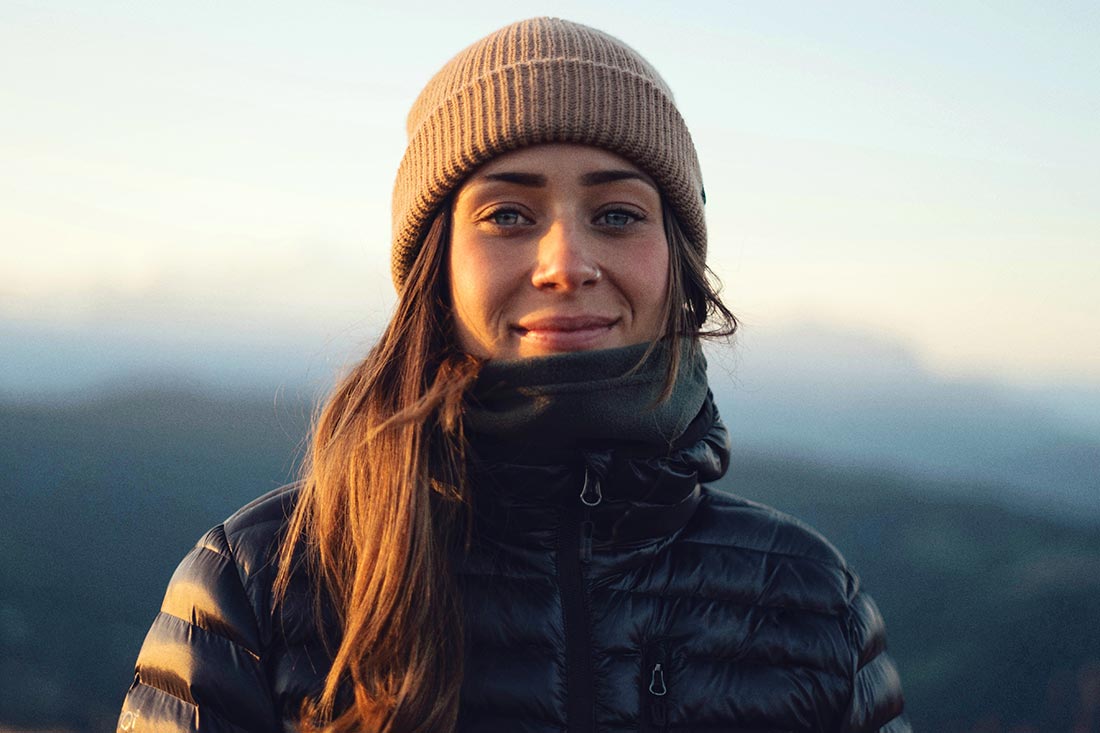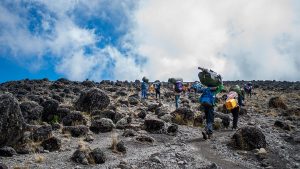Climbing Kilimanjaro requires individuals to purchase or rent quite a bit of gear. One of the items you will definitely need is a good insulating jacket. With all the choices, how do you choose a jacket for climbing Kilimanjaro?
First of all, it should be rated down to -15 degrees Fahrenheit or so. The summit can get very cold—below freezing. That combined with the wind and darkness can chill you to the bone. To avoid this you should dress in layers with a good jacket that is both waterproof and windproof to wear as your top layer.
This article will break down how to find a suitable down jacket, puffer jacket, or insulated jacket, for the mountain. The easy way to avoid the problem altogether is to rent one from us. Yet, if you would like to have your own, let’s examine what should you look for in a jacket. The first thing you need to decide is if you want one made of down or a synthetic material. Some people are allergic to down, so there isn’t a choice.
Down Jackets
Down comes from the feathers of birds. Feathers keep birds warm because they are soft and fluffy. Ducks and geese provide the down we use. The more mature the bird, the more loft (fluffiness) and the warmer its feathers. Besides being lightweight, down is very effective at insulating. The tiny fibers in each cluster allow air to loft between them. The pockets absorb air, allowing it to heat up while allowing the material to breathe. The second advantage of down is that it can be packed very small and, despite the compression, it remains durable. Due to this reason, down is the most effective insulator known to man. A down jacket keeps you warm without weighing you down. There are three things to consider when purchasing a down-insulated product: fill weight, fill power, and down-to-feather ratio. Below we will cover all three properties of down.
Fill Weight
The fill weight of the down refers to how much insulation is in the jacket. Typically, the higher the fill weight, the heavier the product. A jacket with a high fill power but low fill weight ends up being insufficient as there is not enough insulation to stay warm despite using a high loft down. That is why it is important to check the actual weight of the down in addition to the fill power when reviewing a down jacket. Many manufacturers show their fill power and fail to mention their fill weight. But the weight of the jacket is a reasonable sign of the amount of fill inside the jacket.
We recommend a fill weight of at least one pound for climbing Kilimanjaro.
Fill Power
Fill power measures the loft of a down product. The number represents how many cubic inches a single ounce of down occupies. For example, a 600-fill power jacket means that one ounce of down can cover 600 cubic inches. An 800-fill power jacket means that one ounce of down can cover 800 cubic inches. Generally, the fill power rating ranges from 300 to 900 and above.
The most common down products have a rating of 550-650. These are considered mid-range products. They have high quality, high loft, and are reasonably priced.
Lower fill powers come from immature geese and ducks and have smaller down clusters.
700-900 fill powers are the highest quality down and are made for extreme weather conditions.
For Kilimanjaro, we recommend at least a 700-fill power. These jackets should hold up to sub-zero temperatures. The higher the fill power, the more air the down can trap. Which means there is more insulated.
Most people initially think a higher fill power automatically refers to a warmer garment. However, the fill power just refers to how much down lofts. It is related to the insulating value of the down but is not the only determinant of warmth in a jacket. A quality jacket has both high fill power and high fill weight.
Down-to-Feather Ratio
Lastly, it would be best if you looked for the down-to-feather ratio of a jacket. The down-to-feather ratio is the amount of down inside a jacket compared to the number of feathers. Because down is warmer than feathers, the higher the ratio of down versus feathers, the warmer the jacket. These ratios are generally listed as 70/30, 80/20, or 90/10. The first number is the percentage of down, the second is the percentage of feathers.
70/30 jackets are good for mild temperatures only. High-quality jackets should have at least an 80/20 down-feather ratio.
90/10 are top-of-the-line products. Aim for at least 80/20 down-to-feather jackets for your Kilimanjaro climb.
Synthetic jackets
What if you can’t or don’t want to use down? Synthetic is the alternative. The main disadvantage of synthetic jackets is that they are heavier and not as warm as down jackets. However, synthetic jacket technology has come a long way and the performance gap is rapidly closing. All synthetics use some form of compressible water-repellent fibers.
Unlike down, synthetic jackets can keep you warm even when wet. Synthetic is also cheaper and less bulky.
Judging the insulating capabilities of synthetic jackets is more difficult than down. There are no standards for evaluation such as fill power, fill weight, and down-to-feather ratios.
One thing to keep in mind is that the puffiness of a jacket is not necessarily indicative of its warmth. Still, a thin jacket almost certainly is not going to be enough for Kilimanjaro.
Look to see if the manufacturer offers some information on what temperatures are for the jacket. For instance, some companies will clearly state the temperature rating of the jacket, which is the lowest temperature that an average person would feel comfortable with while wearing the jacket at rest.
Down Vs. Synthetic
Final Thoughts
Hopefully, this will make it easier for you to make sense of all the numbers when you choose a jacket for climbing Kilimanjaro. Remember, it’s important to pay attention to all aspects of the jacket. The last thing you want to be is cold while you are trying to make it to the summit. Again, if you are confused by all these numbers and don’t think an extreme jacket is something you’ll use in the future, then rent one from us and not worry about it.





